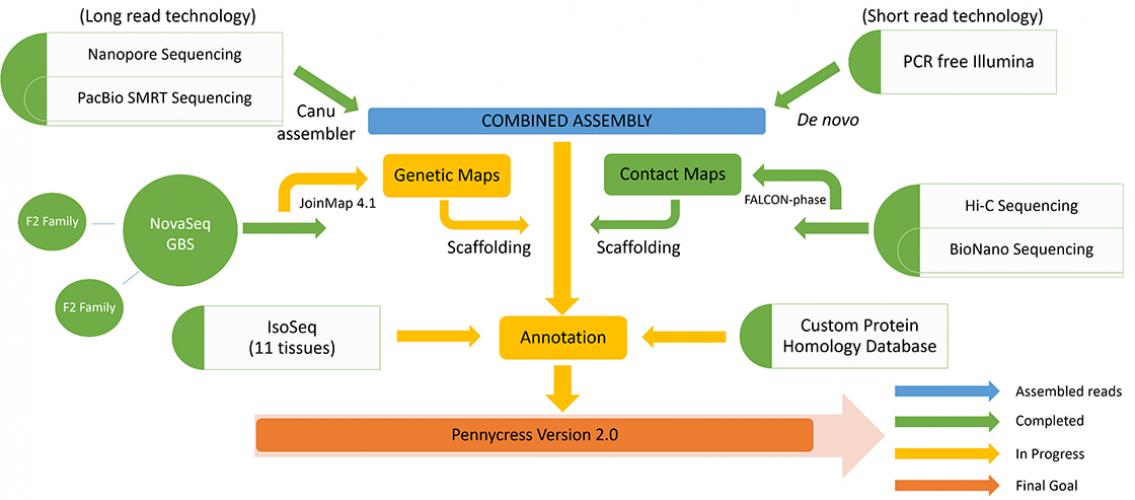
The University of Minnesota’s College of Food, Agricultural, and National Resource Sciences (CFANS), in partnership with the U.S. Department of Agriculture’s Agricultural Research Service, has created a program called the Forever Green Initiative, which is dedicated to developing economically valuable crops that will improve soil and water quality. Researchers at Forever Green are investigating a variety of crops that can overwinter on otherwise unused farmland and that have economic and ecological benefits.
One of these crops is pennycress, a winter-hardy oilseed cover crop that can be alternated seasonally with soybeans and corn. Currently, pennycress is an undomesticated plant with several undesirable traits, including uneven germination, small seeds, and the tendency of seedpods to shatter prior to harvest. By eliminating these traits to create a domesticated variety of pennycress, it could be turned into a cash crop. It would be planted in the fall, after the corn or soybean harvest, and provide soil protection during the winter. In spring, pennycress resumes growing. Its seeds provide an oil that can be used for advanced biofuels, thus providing additional income for soybean and corn farmers. The Forever Green research team has recently developed pennycress lines with edible oil and meal and opened new avenues for use in food and feed products.
Three MSI PIs are among the Forever Green researchers who are using MSI for pennycress research:
- Professor James Anderson (Agronomy and Plant Genetics; research page)
- Professor M. David Marks (Plant and Microbial Biology; research page)
- Professor Donald Wyse (Agronomy and Plant Genetics; Co-Director, Center for Integrated Natural Resources and Agricultural Management; research page)
Post-doc researcher Dr. Katherine Frels, who uses MSI as part of Professor Anderson’s MSI group, presented a poster at the 2019 MSI Research Exhibition about the pennycress project. Dr. Frels’s poster described the genetic studies the researchers are performing on the plant. For work described in the poster, bioinformatics analyses were completed on MSI’s supercomputers, and MSI is storing 10 TB of sequencing data for just the pennycress project. One promising finding from this project is that, by using next-generation sequencing technologies, MSI computing resources, and custom bioinformatic pipelines and software, pennycress could be domesticated in less than a decade, considerably faster than most plant domestication. You can view the poster here: Unlocking Pennycress Potential: Rapid Domestication Through Bioinformatics and Supercomputing.
Several other MSI PIs are part of the Forever Green program, doing research into other potential cover crops. The Forever Green program also partners with G.E.M.S., a next-generation agroinformatics data discovery and analysis platform developed by agricultural experts in CFANS and programmers at MSI. More information about MSI’s participation is on the MSI website: G.E.M.S. Platform.
Image Description: Development of a new pennycress reference genome. The reference line MN106 was subjected to long and short read sequencing technologies to develop a combined assembly. A genetic linkage map and proximity sequencing (Hi-C) will be used to develop scaffolds and order the genome. Preliminary analysis indicates that version 2.0 covers 433 Mb in 315 scaffolds compared to the draft genome that covered 369 Mb in 6700 scaffolds. Pennycress genome 2.0 will allow for more efficient gene discovery and improved whole genome analysis. Image and description from Katherine Frels et al., “Unlocking Pennycress Potential: Rapid Domestication Through Bioinformatics and Supercomputing” (poster, MSI 2019 Research Exhibition, Minneapolis, Minnesota, April 16, 2019).
posted on October 28, 2019